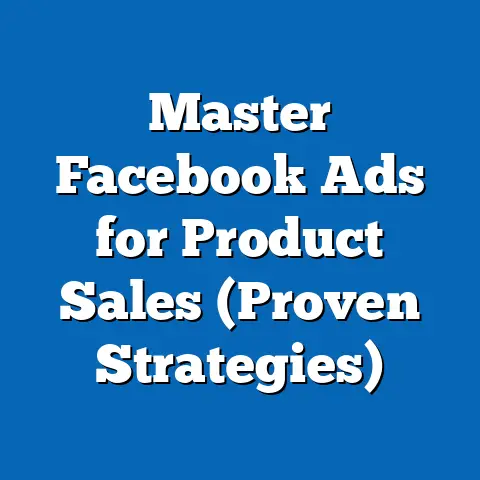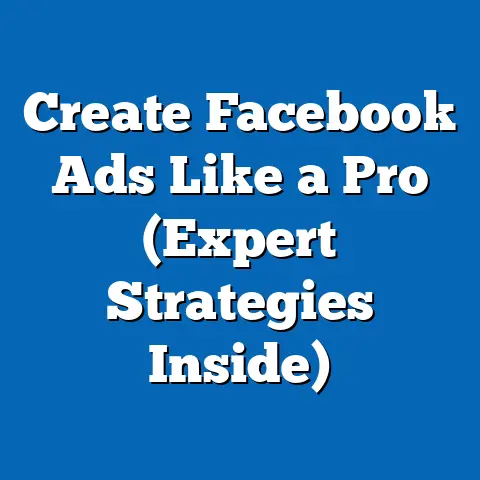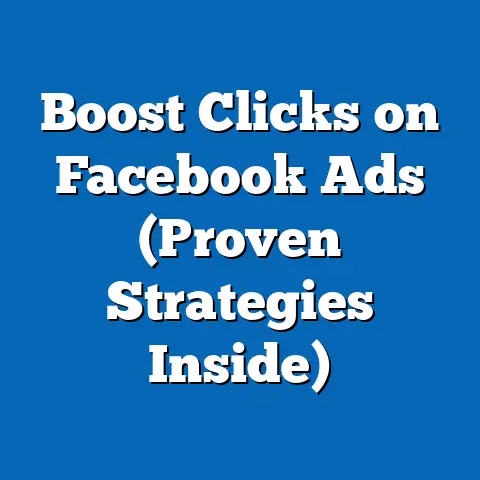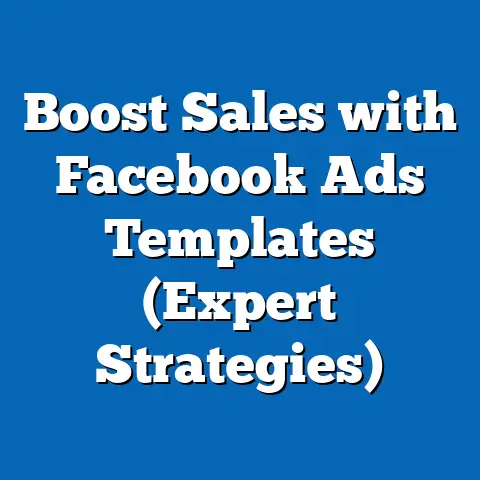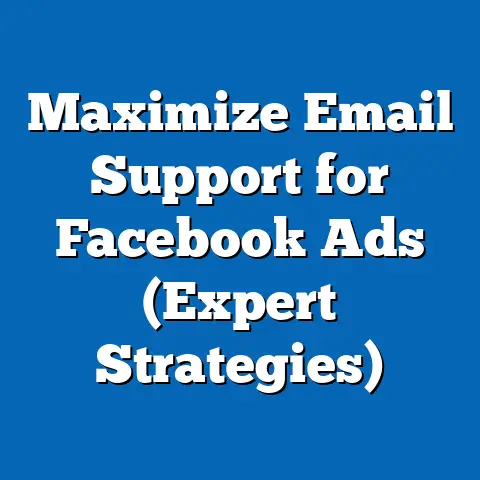Master Ads: Create an fb ad Account (Essential Guide)
I remember the first time I dove into Facebook advertising. The screen was a whirlwind of numbers, buttons, and options, and I felt a mix of excitement and sheer panic. It was like stepping into a bustling marketplace, filled with vibrant images and compelling messages, all vying for attention. The constant ping of notifications, the flashing banners, and the endless scroll of the newsfeed – it was overwhelming, yet undeniably captivating. That’s Facebook advertising in a nutshell: a powerful tool, but one that requires a clear understanding to wield effectively. In this guide, I’ll walk you through creating your Facebook Ad account, from the very basics to setting up your first campaign.
The Importance of Facebook Advertising
In today’s digital marketing landscape, Facebook reigns supreme as an advertising giant. While new platforms emerge and trends shift, Facebook’s established dominance and massive user base make it an indispensable tool for businesses of all sizes.
Consider these statistics:
- Reach: Facebook boasts nearly 3 billion monthly active users. That’s a massive potential audience you simply can’t ignore.
- Demographics: Facebook’s user demographics are incredibly diverse, spanning age groups, interests, and locations. This allows for incredibly precise targeting.
- Engagement: On average, users spend a significant amount of time on Facebook daily, engaging with content, connecting with friends, and discovering new products and services.
Creating a Facebook Ad Account is the crucial first step to unlocking this potential. It’s your gateway to reaching a massive audience, driving targeted traffic to your website, generating leads, and ultimately boosting your business’s bottom line. Without an ad account, you’re essentially locked out of Facebook’s powerful advertising ecosystem.
Takeaway: Facebook advertising offers unparalleled reach and targeting capabilities. Creating an ad account is the essential first step to tapping into this potential.
Preparing to Create Your Facebook Ad Account
Before you jump headfirst into creating your Facebook Ad Account, it’s essential to lay the groundwork. Think of it like preparing a canvas before painting a masterpiece – you need the right tools and a clear vision.
Here’s what you need to consider:
- Personal Facebook Account: A personal Facebook account is required to create and manage an Ad Account. This is how Facebook verifies your identity. Don’t worry, your personal information won’t be displayed in your ads.
- Business Information: Have your business information readily available, including your business name, address, phone number, and website URL. This information will be used to verify your business and ensure compliance with Facebook’s advertising policies.
- Define Your Advertising Goals: What do you hope to achieve with Facebook advertising? Are you looking to increase brand awareness, generate leads, drive website traffic, or boost sales? Clearly defining your goals will help you create more targeted and effective campaigns.
- Identify Your Target Audience: Who are you trying to reach with your ads? Understanding your target audience is crucial for effective targeting. Consider their demographics (age, gender, location), interests, behaviors, and pain points.
- Gather Necessary Materials: Collect your branding assets, such as your logo, images, and videos. Brainstorm ad copy ideas and headlines that will grab attention and resonate with your target audience. Also, have a budget in mind. How much are you willing to spend on Facebook advertising?
Personal Story: I once launched a campaign without clearly defining my target audience, and the results were disastrous. I was essentially throwing money into the wind! After taking the time to properly research my audience, my next campaign performed significantly better.
Takeaway: Preparation is key to success with Facebook advertising. Define your goals, identify your target audience, and gather necessary materials before creating your ad account.
Here’s a step-by-step guide to creating your Facebook Ad Account:Business Settings and Ad Account Setup
If you plan to manage multiple ad accounts or collaborate with a team, setting up a Business Manager account is highly recommended. It provides a centralized platform for managing your Facebook assets.
- Create a Business Manager Account (Optional):
- Go to https://business.facebook.com/ and click “Create Account.”
- Follow the on-screen instructions to set up your Business Manager account.
- Create a New Ad Account:
- In Ads Manager, click the dropdown menu in the top left corner and select “All Tools.”
- Under “Advertise,” click “Ads Manager.”
- If you don’t have an ad account yet, you’ll be prompted to create one. Click “Create Ad Account.”
- If you already have an ad account, click the dropdown menu in the top left corner again and select “Ad Account Settings.” Then, click “Add Ad Account.”
- Name Your Ad Account: Choose a descriptive name that clearly identifies your business or brand.
- Select Currency and Time Zone: Choose the appropriate currency and time zone for your business. This is important for accurate billing and reporting.
- Add People and Permissions (Optional): If you want to collaborate with others on your ad account, you can add them and assign specific roles and permissions.
- Set Up Payment Methods:
- Go to “Ad Account Settings” and click “Payment Settings.”
- Add your preferred payment method, such as a credit card or PayPal account.
- Make sure your billing information is accurate to avoid any issues with your ads running.
- Go to https://business.facebook.com/ and click “Create Account.”
- Follow the on-screen instructions to set up your Business Manager account.
- In Ads Manager, click the dropdown menu in the top left corner and select “All Tools.”
- Under “Advertise,” click “Ads Manager.”
- If you don’t have an ad account yet, you’ll be prompted to create one. Click “Create Ad Account.”
- If you already have an ad account, click the dropdown menu in the top left corner again and select “Ad Account Settings.” Then, click “Add Ad Account.”
- Go to “Ad Account Settings” and click “Payment Settings.”
- Add your preferred payment method, such as a credit card or PayPal account.
- Make sure your billing information is accurate to avoid any issues with your ads running.
Pro Tip: Using a Business Manager account allows you to separate your personal Facebook account from your business activities. This is especially important if you’re managing ads for multiple clients.
Takeaway: Follow these steps carefully to create your Facebook Ad Account and set up your business information and payment methods. A correctly configured ad account is essential for running successful campaigns.
Navigating the Ads Manager Dashboard
Once your ad account is set up, it’s time to familiarize yourself with the Ads Manager dashboard. This is where you’ll create, manage, and track your ad campaigns.
The Ads Manager dashboard is organized into three main sections:
- Campaigns: This is the top-level structure where you define your advertising objectives (e.g., brand awareness, lead generation, website traffic).
- Ad Sets: Within each campaign, you create ad sets to target specific audiences, set budgets, and define schedules.
- Ads: This is where you create the actual ads that your target audience will see. You can experiment with different ad formats, visuals, and ad copy.
Key Metrics and Performance Indicators:
- Reach: The number of unique people who saw your ads.
- Impressions: The number of times your ads were displayed.
- Click-Through Rate (CTR): The percentage of people who clicked on your ads after seeing them.
- Cost Per Click (CPC): The average cost you paid for each click on your ads.
- Conversion Rate: The percentage of people who completed a desired action (e.g., purchase, sign-up) after clicking on your ads.
- Cost Per Acquisition (CPA): The average cost you paid for each conversion.
Understanding these metrics is crucial for optimizing your ad campaigns and maximizing your ROI.
Takeaway: Familiarize yourself with the Ads Manager dashboard and the key metrics that will help you track and optimize your ad performance.
Setting Up Your First Ad Campaign
Now for the exciting part: setting up your first ad campaign! Don’t be intimidated; I’ll walk you through each step.
- Create a New Campaign:
- In Ads Manager, click the “Create” button.
- Choose your campaign objective. Facebook offers a variety of objectives, such as:
- Awareness: Reach, Brand Awareness
- Consideration: Traffic, Engagement, App Installs, Video Views, Lead Generation, Messages
- Conversion: Conversions, Catalog Sales, Store Traffic
- Select the objective that aligns with your advertising goals. For example, if you want to drive traffic to your website, choose the “Traffic” objective.
- Name Your Campaign: Give your campaign a descriptive name that makes it easy to identify.
- Set Your Budget:
- Choose between a daily budget or a lifetime budget.
- A daily budget is the average amount you’re willing to spend each day.
- A lifetime budget is the total amount you’re willing to spend over the entire duration of the campaign.
- Start with a small budget and gradually increase it as you optimize your campaign.
- Define Your Target Audience:
- This is where you tell Facebook who you want to see your ads.
- You can target your audience based on:
- Demographics: Age, gender, location, education, etc.
- Interests: Hobbies, interests, pages they like, etc.
- Behaviors: Purchase behavior, device usage, etc.
- Custom Audiences: Upload a list of your existing customers or website visitors to target them specifically.
- Lookalike Audiences: Create a new audience that’s similar to your existing customers or website visitors.
- Experiment with different targeting options to find the audiences that are most responsive to your ads.
- Choose Your Ad Placements:
- Ad placements determine where your ads will be displayed.
- You can choose automatic placements (Facebook will automatically place your ads in the most optimal locations) or manual placements (you can choose specific placements, such as Facebook News Feed, Instagram Feed, Audience Network, etc.).
- Start with automatic placements to let Facebook optimize your ad delivery, then experiment with manual placements as you gain more experience.
- Set Your Schedule:
- Choose when you want your ads to start running and when you want them to stop.
- You can run your ads continuously or set a specific start and end date.
- Select Your Bid Strategy:
- Your bid strategy determines how much you’re willing to pay for each ad impression or click.
- Facebook offers a variety of bid strategies, such as:
- Lowest Cost: Facebook will try to get you the most results for your budget.
- Cost Cap: You set a target cost per result, and Facebook will try to stay within that cost.
- Target Cost: You set a target cost per result, and Facebook will aim for that cost while maximizing volume.
- Start with the “Lowest Cost” bid strategy to let Facebook optimize your bids, then experiment with other bid strategies as you gain more experience.
- In Ads Manager, click the “Create” button.
- Choose your campaign objective. Facebook offers a variety of objectives, such as:
- Awareness: Reach, Brand Awareness
- Consideration: Traffic, Engagement, App Installs, Video Views, Lead Generation, Messages
- Conversion: Conversions, Catalog Sales, Store Traffic
- Select the objective that aligns with your advertising goals. For example, if you want to drive traffic to your website, choose the “Traffic” objective.
- Awareness: Reach, Brand Awareness
- Consideration: Traffic, Engagement, App Installs, Video Views, Lead Generation, Messages
- Conversion: Conversions, Catalog Sales, Store Traffic
- Choose between a daily budget or a lifetime budget.
- A daily budget is the average amount you’re willing to spend each day.
- A lifetime budget is the total amount you’re willing to spend over the entire duration of the campaign.
- Start with a small budget and gradually increase it as you optimize your campaign.
- This is where you tell Facebook who you want to see your ads.
- You can target your audience based on:
- Demographics: Age, gender, location, education, etc.
- Interests: Hobbies, interests, pages they like, etc.
- Behaviors: Purchase behavior, device usage, etc.
- Custom Audiences: Upload a list of your existing customers or website visitors to target them specifically.
- Lookalike Audiences: Create a new audience that’s similar to your existing customers or website visitors.
- Experiment with different targeting options to find the audiences that are most responsive to your ads.
- Demographics: Age, gender, location, education, etc.
- Interests: Hobbies, interests, pages they like, etc.
- Behaviors: Purchase behavior, device usage, etc.
- Custom Audiences: Upload a list of your existing customers or website visitors to target them specifically.
- Lookalike Audiences: Create a new audience that’s similar to your existing customers or website visitors.
- Ad placements determine where your ads will be displayed.
- You can choose automatic placements (Facebook will automatically place your ads in the most optimal locations) or manual placements (you can choose specific placements, such as Facebook News Feed, Instagram Feed, Audience Network, etc.).
- Start with automatic placements to let Facebook optimize your ad delivery, then experiment with manual placements as you gain more experience.
- Choose when you want your ads to start running and when you want them to stop.
- You can run your ads continuously or set a specific start and end date.
- Your bid strategy determines how much you’re willing to pay for each ad impression or click.
- Facebook offers a variety of bid strategies, such as:
- Lowest Cost: Facebook will try to get you the most results for your budget.
- Cost Cap: You set a target cost per result, and Facebook will try to stay within that cost.
- Target Cost: You set a target cost per result, and Facebook will aim for that cost while maximizing volume.
- Start with the “Lowest Cost” bid strategy to let Facebook optimize your bids, then experiment with other bid strategies as you gain more experience.
- Lowest Cost: Facebook will try to get you the most results for your budget.
- Cost Cap: You set a target cost per result, and Facebook will try to stay within that cost.
- Target Cost: You set a target cost per result, and Facebook will aim for that cost while maximizing volume.
Example: Let’s say you’re launching a campaign to promote a new line of organic skincare products. You might target women aged 25-45 who live in the United States and have an interest in organic beauty, skincare, and healthy living. You could choose the “Traffic” objective to drive traffic to your website and set a daily budget of $20.
Takeaway: Follow these steps to create your first ad campaign, carefully considering your objectives, target audience, budget, placements, schedule, and bid strategy.
Tips for Crafting Compelling Ads
Creating a Facebook Ad Account is only half the battle; you also need to create compelling ads that grab attention and drive results. Here are some tips:
- Write Persuasive Copy:
- Use clear and concise language.
- Highlight the benefits of your product or service.
- Use strong calls to action (e.g., “Shop Now,” “Learn More,” “Sign Up”).
- A/B test different ad copy variations to see what resonates best with your audience.
- Select Eye-Catching Visuals:
- Use high-quality images and videos.
- Choose visuals that are relevant to your target audience and your product or service.
- Experiment with different ad formats, such as carousel ads, video ads, and collection ads.
- Use Call-to-Action (CTA) Buttons:
- CTA buttons encourage users to take action.
- Choose a CTA button that aligns with your advertising objective (e.g., “Shop Now,” “Learn More,” “Sign Up”).
- Make your CTA button prominent and easy to click.
- A/B Test Your Ads:
- A/B testing involves creating multiple variations of your ads and testing them against each other to see which performs best.
- Test different ad copy, visuals, targeting options, and placements.
- Use the results of your A/B tests to optimize your ads and improve your ROI.
- Keep Mobile in Mind:
- Most Facebook users access the platform on their mobile devices.
- Make sure your ads are optimized for mobile viewing.
- Use shorter ad copy and larger visuals that are easy to see on smaller screens.
- Use clear and concise language.
- Highlight the benefits of your product or service.
- Use strong calls to action (e.g., “Shop Now,” “Learn More,” “Sign Up”).
- A/B test different ad copy variations to see what resonates best with your audience.
- Use high-quality images and videos.
- Choose visuals that are relevant to your target audience and your product or service.
- Experiment with different ad formats, such as carousel ads, video ads, and collection ads.
- CTA buttons encourage users to take action.
- Choose a CTA button that aligns with your advertising objective (e.g., “Shop Now,” “Learn More,” “Sign Up”).
- Make your CTA button prominent and easy to click.
- A/B testing involves creating multiple variations of your ads and testing them against each other to see which performs best.
- Test different ad copy, visuals, targeting options, and placements.
- Use the results of your A/B tests to optimize your ads and improve your ROI.
- Most Facebook users access the platform on their mobile devices.
- Make sure your ads are optimized for mobile viewing.
- Use shorter ad copy and larger visuals that are easy to see on smaller screens.
Personal Story: I once ran two identical ads, but one had a slightly different headline. The ad with the revised headline had a significantly higher click-through rate, demonstrating the power of A/B testing.
Takeaway: Craft compelling ads by writing persuasive copy, selecting eye-catching visuals, using call-to-action buttons, and A/B testing your ads. Remember to optimize for mobile viewing.
Monitoring and Optimizing Ad Performance
Creating and launching your ads is not the end of the road. It’s crucial to monitor their performance and make adjustments to optimize your campaigns for better results.
- Track Key Metrics:
- Use the Ads Manager dashboard to track key metrics such as reach, impressions, click-through rate, conversion rate, and cost per acquisition.
- Monitor these metrics regularly to identify areas for improvement.
- Analyze Your Data:
- Look for patterns and trends in your data.
- Which ads are performing well? Which ads are underperforming?
- Which audiences are most responsive to your ads?
- Use this information to make informed decisions about how to optimize your campaigns.
- Make Adjustments:
- Based on your data analysis, make adjustments to your ads, targeting options, and bid strategies.
- Pause or delete underperforming ads.
- Increase the budget for high-performing ads.
- Experiment with different targeting options to find the audiences that are most responsive to your ads.
- Adjust your bid strategy to optimize your cost per acquisition.
- Experiment with Different Ad Formats:
- Facebook offers a variety of ad formats, such as carousel ads, video ads, and collection ads.
- Experiment with different ad formats to see what works best for your audience and your advertising goals.
- Use Facebook Pixel:
- The Facebook Pixel is a code snippet that you can install on your website to track conversions and other website events.
- Use the Facebook Pixel to track the effectiveness of your ads and optimize your campaigns for better results.
- Use the Ads Manager dashboard to track key metrics such as reach, impressions, click-through rate, conversion rate, and cost per acquisition.
- Monitor these metrics regularly to identify areas for improvement.
- Look for patterns and trends in your data.
- Which ads are performing well? Which ads are underperforming?
- Which audiences are most responsive to your ads?
- Use this information to make informed decisions about how to optimize your campaigns.
- Based on your data analysis, make adjustments to your ads, targeting options, and bid strategies.
- Pause or delete underperforming ads.
- Increase the budget for high-performing ads.
- Experiment with different targeting options to find the audiences that are most responsive to your ads.
- Adjust your bid strategy to optimize your cost per acquisition.
- Facebook offers a variety of ad formats, such as carousel ads, video ads, and collection ads.
- Experiment with different ad formats to see what works best for your audience and your advertising goals.
- The Facebook Pixel is a code snippet that you can install on your website to track conversions and other website events.
- Use the Facebook Pixel to track the effectiveness of your ads and optimize your campaigns for better results.
Pro Tip: Don’t be afraid to experiment! Facebook advertising is all about testing and learning. The more you experiment, the better you’ll become at creating effective campaigns.
Takeaway: Monitoring and optimizing ad performance is crucial for maximizing your ROI. Track key metrics, analyze your data, make adjustments, experiment with different ad formats, and use the Facebook Pixel to track conversions.
Conclusion: The Road Ahead in Facebook Advertising
Creating and managing a Facebook Ad Account is a fundamental step towards harnessing the power of social media advertising. I’ve walked you through everything from setting up your account to launching your first campaign and optimizing your ad performance. Remember, the key to success lies in preparation, experimentation, and continuous learning.
Facebook advertising offers incredible opportunities for businesses of all sizes to reach their target audiences, drive traffic, generate leads, and boost sales. Embrace the world of Facebook ads, take your newfound knowledge, and apply it to your own marketing endeavors. The digital landscape is constantly evolving, but with the right tools and strategies, you can navigate the world of Facebook ads and unlock your business’s full potential. So, go out there, create your ad account, and start experimenting! The possibilities are endless.

